This post may contain affiliate links which may generate a small commission from clicks that result in a purchase.
Olive tree leaves yellow with black spots because of a fungal disease called peacock spot or olive leaf spot (also others call it – bird’s eye spot or olive scab). This fungal disease is highly contagious and can seriously weaken the olive tree, with the best method being prevention. Olive tree pruning and sprays may help.
When olive trees get this fungus it starts developing black spots on the leaves which eventually causes the leaves to turn yellow and drop off. Let’s take a closer look at what causes it and how to fix it.
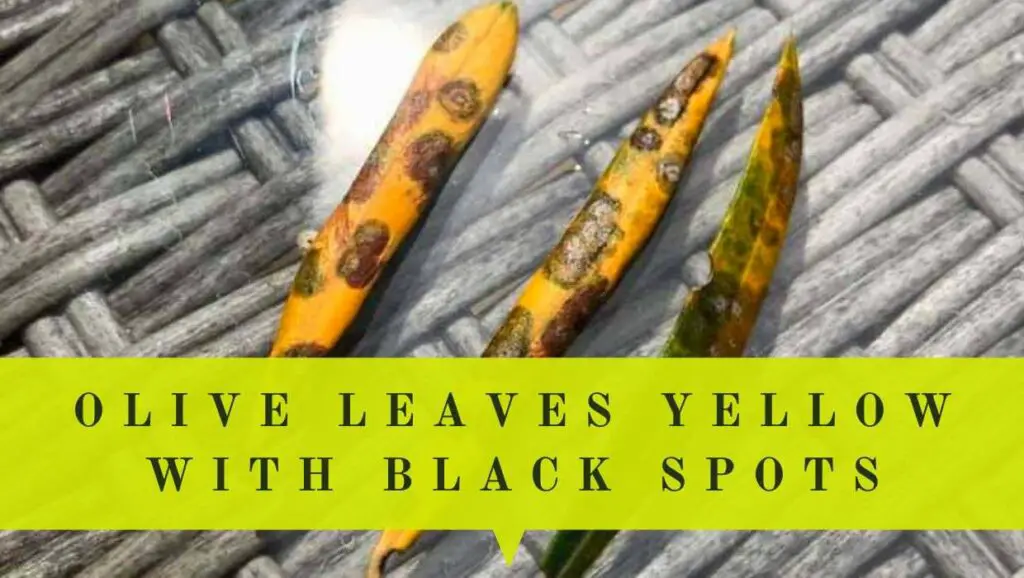
What Do Black Spots on Olive Leaves Do?
Olive tree leaves yellow with black spots about 0.1 to 0.5 inches (2.5 – 12 mm) in diameter if affected by fungal diseases Leaf Spot or Peacock Spot (Spilocaea oleaginea). The outer margins of the black spots are jagged or feathery and they are usually surrounded by a ring of yellow (source).
This fungus infection occurs in the fall with black spots typically beginning on the lower olive leaves and moving upward. These spots can enlarge and eventually merge. Affected olive leaves yellow and often fall off the tree. And if left unchecked, the entire olive tree can defoliate.
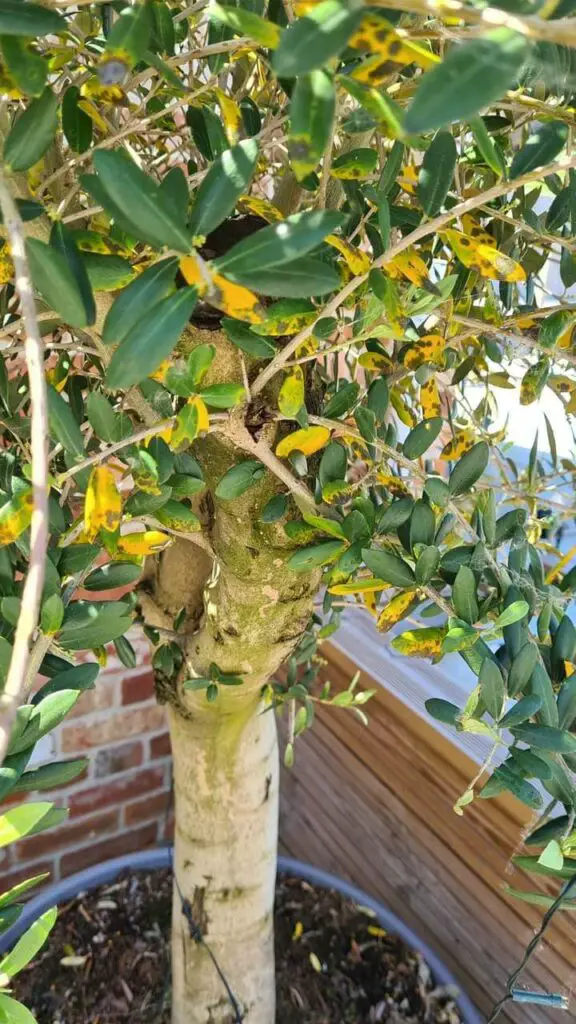
Moreover, infected olive trees will set fewer olive flower buds and without leaves, the olive trees become stressed and susceptible to more problems. If the infection is significant and defoliation occurs, strong bloom fails to develop and olive production is substantially reduced. Twig death may follow as a result of defoliation, and productivity is eventually further reduced.
Olive leaf spot is common worldwide and serious in cooler olive growing regions, with yield losses estimated up to 20% (source)
Environmental Controls for the Problem
Black spot fungus infection occurs in the fall waiting for favorable conditions: with temperatures between 35°F and 80°F (2°C and 27°C) and about 48 hours of free moisture the germinating spores allow to infect the olive leaf and cause significant disease (source).
By the time temperatures reach the sixties, the disease is running rampant and won’t slow down until the daytime temperatures rise above 80°F (27°C). The warmer the temperature, the shorter time necessary for infection to occur, it can take one day only.
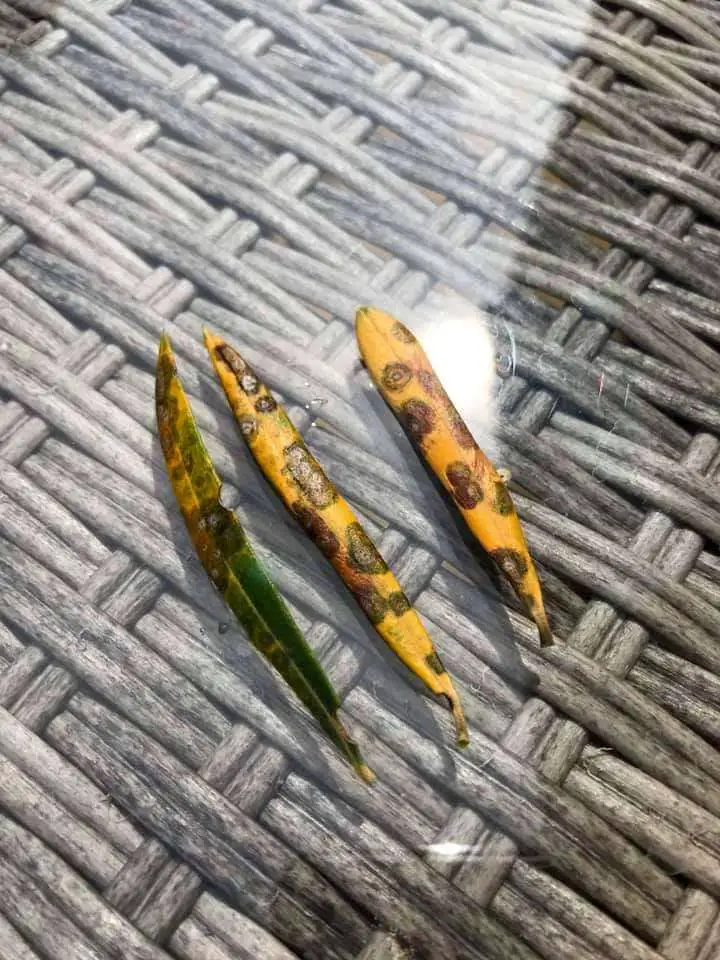
It starts with tiny black spots on the upper leaf surfaces of leaves low in the olive tree canopy. As the fungus develops, those black spots on olive leaves are ringed with yellow. Soon the entire leaf turns yellow and falls prematurely. This fungus disease also infects fruits and fruit stems and twigs with olive production substantially reduced.
How to Treat Black Spots on Olive Tree Leaves?
1. Prevention
Prevention is the best way to minimize and stop olive tree diseases. Prevention is more proactive than other approaches and is very powerful if you give the olive tree ideal growing conditions and keep it a healthy, vigorous tree that is less susceptible to problems.
Ideal Growing Conditions
Olive trees prefer a sunny location with well-draining soil, hot dry summers, and cool winters.
So place olive trees where they receive full day sun which helps dry moisture from leaves and protect from spreading the fungus spores.
Good Air Flow
Provide good air circulation around and through your olive trees. Do not plant your olive trees too close to other plants or trees. Prune to open the trunk if the olive tree gets too dense and air can not get through.
By providing good air circulation and ensuring olive branches don’t cross, black spot disease will have a harder time spreading.
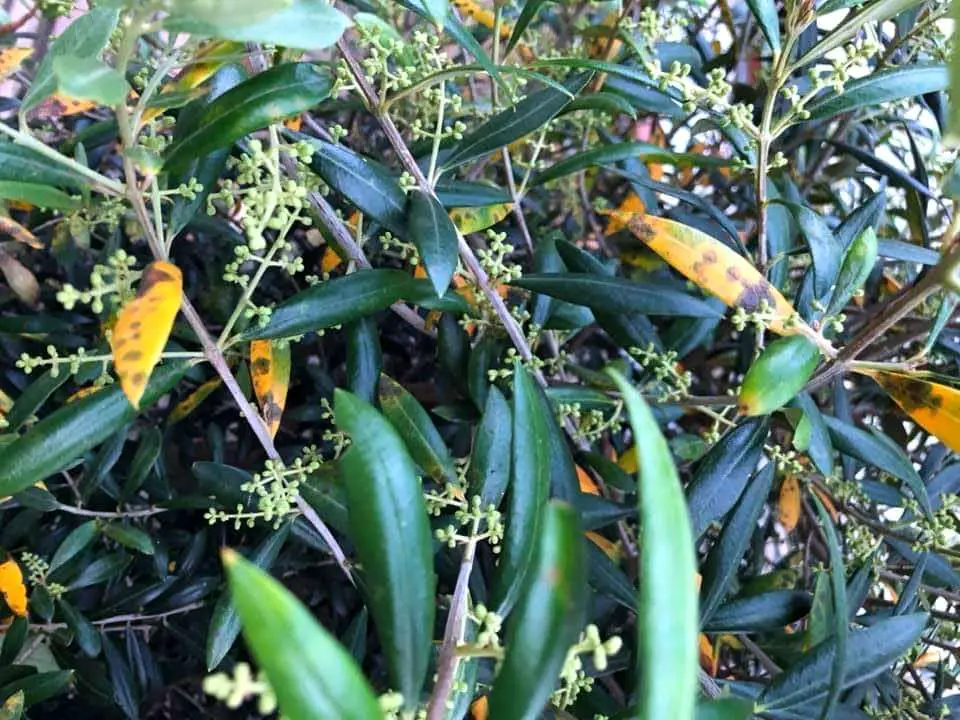
Proper Watering
When watering, avoid getting the leaves wet as this spreads infection from leaf to leaf. There is not much you can do about rain, but avoid overhead sprinklers and focus water directly on the tree’s roots.
2. Pruning
Pruning is one of the best practices to limit the spread of black spots and other diseases. By pruning the diseased branches, you are preventing the spread of the disease to other leaves and branches that have yet to be infected.
Remove any infected olive leaves and always do a thorough cleanup each fall. Remove and dispose of any remaining olive leaves and branches when you do olive tree dormant pruning after harvest. Fungus spores can remain on leaves and stems and can reinfect whenever conditions are favorable.
Fungus spores spread by water, so it’s best to avoid pruning in wet weather. Prune out any branches showing signs of infection.
Disinfect your pruning shears with a 10 percent bleach solution or alcohol between cuts. While cleaning pruning shears might seem unnecessary, remember that these diseases are highly infectious and can be easily transmitted from branch to branch. Add to this that pruning exposes the tree’s cells – giving these diseases direct access to the tree’s immune system.
Dispose of infected olive leaves and branches – do not compost them, as the spores can re-infect other plants. Make sure to clean up fallen olive leaves as well, and dispose of them properly.
It is highly recommended to prune diseased olive branches whenever you see them, no matter the time of year.
Pruning in the Summer Tips
Because olive tree diseases commonly spread in temperatures above 60°F (16°C), pruning infected branches in the summer can be a bit tricky. The best approach in summer is to prune the branches at least 10 -15 inches (25 – 40 cm) below where the blackened or diseased areas start.
Pruning in the Winter Tips
In the winter, especially below 35°F (2°C), many diseases are largely dormant. Because of this, you can cut the infected branches right before the start of the disease site (unlike the 10 -15 inches (25 – 40 cm) suggested in the summer months). Pruning in winter greatly limits the spread.
3. Sprays for Treatment and Prevention
There are commercial and homemade, DIY-solutions you can use to try to prevent the spread of black spot disease on olive tree leaves. The most effective solution includes fungicide (especially copper) treatments during the main infection seasons (spring and autumn).
If after you have treated the olive tree, the black spots on leaves reoccur, you may need to spray your olive tree weekly.
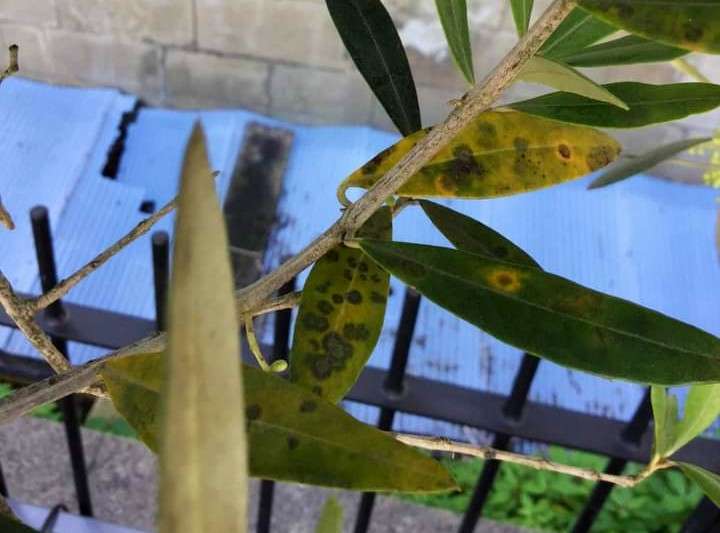
Baking Soda Spray
Baking soda spray works as a preventive mixture and also offers some protection from powdery mildew.
You can make it easily at home by dissolving 1 teaspoon of baking soda in 1 quart of warm water and adding up to 1 teaspoon of liquid soap. Then spray olive leaves thoroughly.
Bordeaux Mix
Bordeaux mix is a fungicide that contains copper sulfate and hydrated lime which can be used as a preventative in the spring before the olive tree growth cycle.
This mixture is used as a powder or mixed with water and sprayed. Bordeaux mix also repels some insect pests on olive tree leaves, but it can burn plant leaves so use it according to the product instructions.
Insecticidal Soaps with Added Fungicide
The best is to use an organic fungicide, which is often sulfur added to regular insecticidal soap. Such mixture coats the leaves and helps the fungicide stick to the olive tree.
Neem Oil
Neem is a very common organic fungicide and pesticide, derived from the seeds of the neem tree.
After applying it to the olive tree, it gets inside the tree’s system, so you do not need to worry about coating everything or reapplying it after rain.
However, it can burn olive tree leaves in the hot sun. Also, you should not apply neem oil within two weeks of using a product containing sulfur.
Sulfur
Sulfur is a natural element that is essential to the olive tree but also is a good natural fungicide that kills on contact, effectively treats, and prevents black spots. Also, it is a good pesticide to control several insect pests (source).
Sulfur comes in many forms including liquids, wettable powder, and dust. If you prefer to spray it on your olive tree, look for one that has a wettable feature on a label so that it will mix with water.
Resistant Cultivars
Unfortunately, no olive tree varieties are truly resistant to this fungus, however, some are better than others.
Based on the research on the phenotypic profile of varieties (resistant/ susceptible) related to olive leaf spot or peacock spot, the olive cultivar is classified in accordance to the percentage of infected leaves:
| Olive Cultivar Classiffication | Disease incidence ( % of Infected Leaves by Olive Leaf Spot) |
|---|---|
| Lowly Susceptible | Disease incidence lower than 30% of infected leaves |
| Medium Susceptible | Disease incidence lower than 60% of infected leaves |
| Medium – Highly Susceptible | Disease incidence lower than 80% of infected leaves |
| Highly Susceptible | Disease incidence higher than 80% of infected leaves |
The highest percentage (above 80%) of infected leaves was observed in the following cultivar:
| Highly Susceptible Olive Cultivar related to Olive Leaf Spot | Origin |
|---|---|
| Carolea | Italy |
| Casaliva | Italy |
| Cornicabra | Spain |
| Fecciaro | Italy |
| Giarraffa | Italy |
| Grossa di Spagna | Italy |
| Hojiblanca | Spain |
| Konservolia | Greece |
| Moraiolo | Italy |
| Morchiaio | Italy |
| Moresca | Italy |
| Ogliarola Salentina | Italy |
| Picholine Marocaine | Morroco |
| Picual | Spain |
| Raza | Italy |
| Tanche | France |
| Verdale | France |
The following cultivars can be considered medium – highly susceptible with a percentage of infected leaves ranging from 60 to 78:
| Medium – Highly Susceptible Olive Cultivar related to Olive Leaf Spot | Origin |
|---|---|
| Arbequina | Spain |
| Bella di Cerignola | Italy |
| Coratina | Italy |
| Corniolo | Italy |
| Dritta di Loreto | |
| Dritta di Moscufo | Italy |
| Frantoio | Italy |
| Gentile di Chieti | Italy |
| Grossanne | France |
| Kalamata | Greece |
| Laurina | Italy |
| Lechin de Sevilla | Spain |
| Manzanilla | Spain |
| Manzanilla carresquena | Spain |
| Nostrale di Rigali | Italy |
| Ogliarola di Bitonto | Italy |
| Pendolino | Italy |
| Rastrellina | Italy |
| San Felice | Italy |
| Santa Caterina | Italy |
| Santagatese | Italy |
| Sargano | Italy |
| Taggiasca | Italy |
Another group of cultivars can be considered medium-susceptible to Olive Leaf Spot / Peacock Spot with a percentage of infected leaves ranging from 30 to 60:
| Medium Susceptible Olive Cultivar related to Olive Leaf Spot | Origin |
|---|---|
| Ascolana semitenera | Italy |
| Ascolana tenera | Italy |
| Canino | Italy |
| Cima di Mola | Italy |
| Cipressino | Italy |
| Cucca | Italy |
| Dolce Agogia | Italy |
| Gordal Sevillana | Spain |
| Gordales | Spain |
| Itrana | Italy |
| Maurino | Italy |
| Mignola | Italy |
| Orbetana | Italy |
| Ottobratica | Italy |
| Piangente | Italy |
| Picholine De Languedoc | France |
| Razzola | Italy |
| Rosciola | Italy |
| Sant’ Agostino | Italy |
| Sorani | Syria |
| Uovo di Piccione | Italy |
The lowest percentage (below 30%) of infected leaves was observed in the following cultivars (with the Koroneiki variety the lowest with a bit above 20%):
| Lowly Susceptible Olive Cultivar related to Olive Leaf Spot | Origin |
|---|---|
| Koroneiki | Greece |
| Leccino | Italy |
| Leccio del corno | Italy |
| Olivago Sabino | Italy |
Final Thoughts
Black spots on olive tree leaves thrive during cool, moist weather, and fungal spores spread the disease to other leaves and trees. While extreme summer heat limits this fungal disease.
For example, this disease occurs throughout California’s olive-growing regions, but coastal areas with high rainfall suffer the most (source).
Good practice in olive cultivation methods, olive cultivar selection, olive groove hygiene, and encouraging or introducing natural enemies, should be the first line of control.
Though if your olive tree has been targeted by black spot fungus, the good news is that black spot fungus on an olive tree rarely kills the host tree. Getting rid of black spot on olive leaves takes a lot of diligence, but in the end, the rewards are worth it.
Hi, I’m Vangelis Kleftogiannis, the founder of Oliviada and an established olive oil expert from Kalamata, Greece. My expertise isn’t just in producing quality Extra Virgin Olive Oil, but also in the cultivation and care of olive trees themselves. I am deeply committed to sharing my knowledge and know-how, helping others understand the intricacies of olive tree growing and the creation of quality olive oil.
Are You Looking to Buy an Olive Tree?
If you are looking to add more potted trees or other plants to your orchard, or if you like to replace a neglected olive tree, the best places to get them are your local nursery or an online nursery.
One of the most reliable and the world's largest online nurseries is Fast Growing Trees. They deliver fast, neat, and healthy plants backed with a 30-day guarantee.
